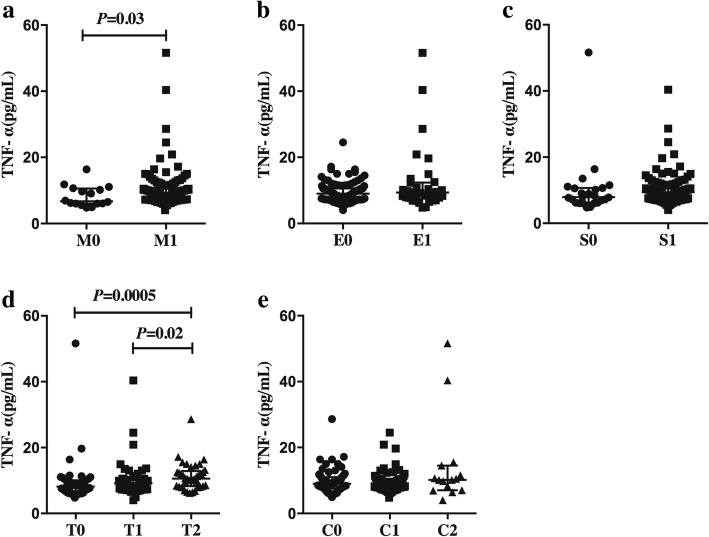Fig. 3.
Correlations between serum levels of tumor necrosis factor alpha (TNF-α) and different grade according to Oxford Classification a. (a) Serum levels of TNF-α were significantly higher in patients with mesangial hypercellularity grade M1 than that in patients with grade M0 [M1: 9.30 (7.90–10.60) pg/mL vs. M0: 6.70 (6.00–10.58) pg/mL, P = 0.03]. (d) Serum levels of TNF-α in patients with tubular atrophy/interstitial fibrosis grade T2 were significantly higher than that in grade T0 [T2: 10.60 (8.25–12.85) pg/mL vs. T0: 6.70 (6.00–10.58) pg/mL, P = 0.0005] and T1 [T2: 10.60 (8.25–12.85) pg/mL vs. T1: 9.20 (8.00–10.20) pg/mL, P = 0.02]; But there was no difference between patients with grade T1 and T0 (P = 0.05). (b, c and e) Serum levels of TNF-α in patients with different grades of endocapillary hypercellularity [E1: 9.35 (7.53–12.35) pg/mL vs. E0: 9.00 (7.75–10.60) pg/mL, P = 0.66], segmental glomerulosclerosis [S1: 9.40 (7.90–10.60) pg/mL vs. S0: 7.90 (6.20–10.68) pg/mL, P = 0.06] and cellular/fibrocellular crescents [C2:10.20 (7.00–14.50) pg/mL vs. C0: 9.00 (7.53–11.03) pg/mL, P = 0.22; C2: 10.20 (7.00–14.50) pg/mL vs. C1: 9.15 (7.80–10.50) pg/mL, P = 0.26; C1: 9.15 (7.80–10.50) pg/mL vs. C0: 9.00 (7.53–11.03) pg/mL, P = 0.81] did not show any significant difference. Statistically significant differences were tested with Mann–Whitney U-test. a Determined in accordance with the Oxford classification [5]

